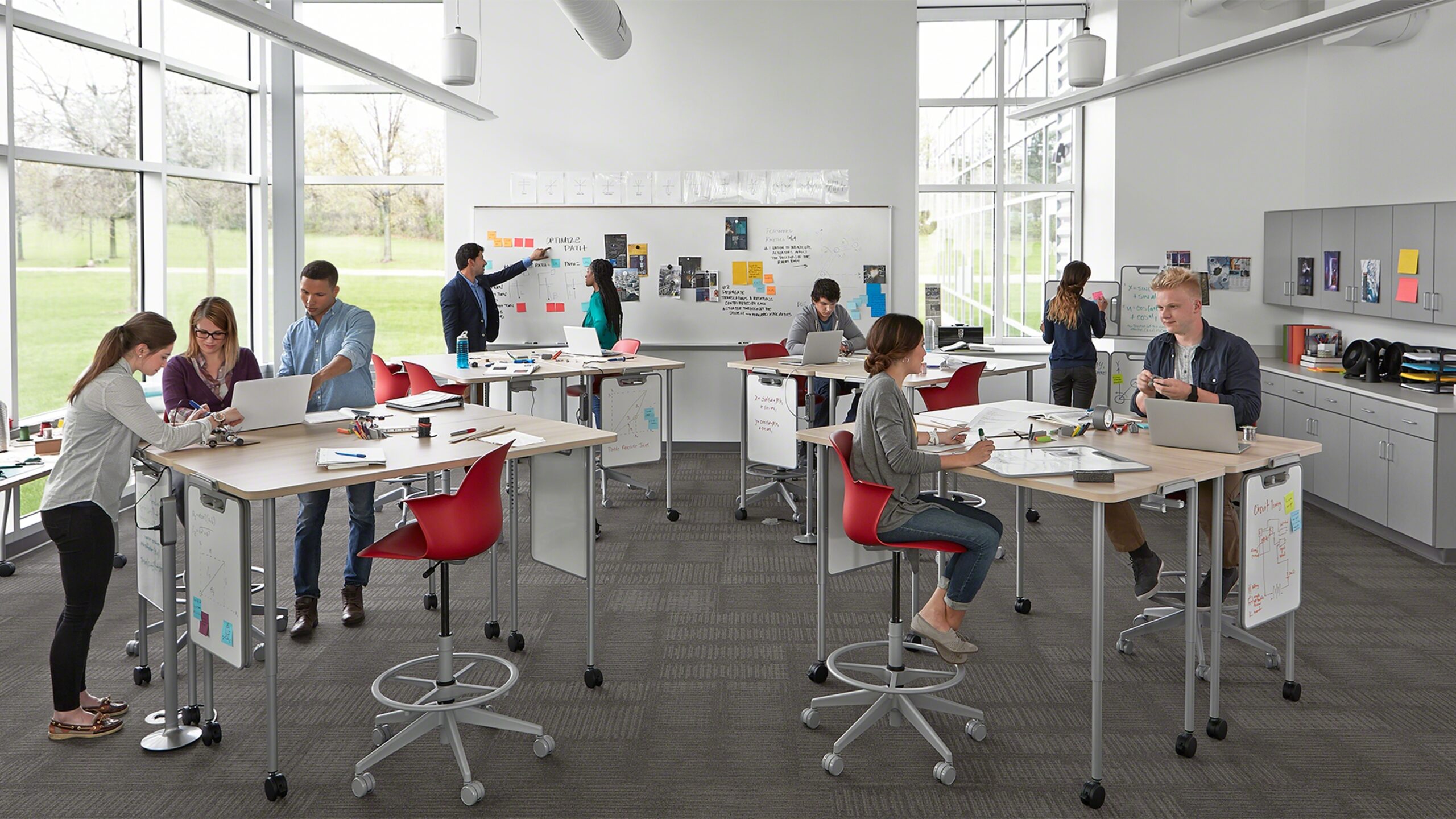Furniture Solutions for Future-Ready Learning
May 8, 2017Work your way. Sit your way. Learn your way.
 Learning commons, maker spaces, break-out rooms and HOMAGO (Hanging Out, Messing Around, and Geeking Out)—these are just a few of the terms to describe rapidly evolving educational spaces. Critical thinking, communication, collaboration and creativity are the four C’s of future-ready learning. Furniture manufacturers have developed a wide array of flexible furniture solutions to help create zones that foster these skills and allow students to work, sit (or stand) and ultimately learn in the manner that works best for them.
Learning commons, maker spaces, break-out rooms and HOMAGO (Hanging Out, Messing Around, and Geeking Out)—these are just a few of the terms to describe rapidly evolving educational spaces. Critical thinking, communication, collaboration and creativity are the four C’s of future-ready learning. Furniture manufacturers have developed a wide array of flexible furniture solutions to help create zones that foster these skills and allow students to work, sit (or stand) and ultimately learn in the manner that works best for them.
 Today’s flexible furniture solutions can be used to create diverse break-out zones to foster the four “C’s” while supporting multiple learning styles. We are highlighting just a few of the many available furniture and zone options to convert a tired, traditional classroom into an energized, adaptable future-ready learning environment.
Today’s flexible furniture solutions can be used to create diverse break-out zones to foster the four “C’s” while supporting multiple learning styles. We are highlighting just a few of the many available furniture and zone options to convert a tired, traditional classroom into an energized, adaptable future-ready learning environment.

Collaboration Zone
This zone requires flexibility, mobility and connectivity to facilitate project learning and group discussions. Mobile work spaces and seating are helpful to accommodate groups that often vary throughout the day—these work spaces adapt to meet individual group needs, rather than requiring groups to conform to static furniture limitations. Writable wall surfaces, white boards or multi-user screens that interconnect several devices are helpful tools for these spaces.

Individual Study Zone
Breakaway spaces with minimal distractions should be reserved for quiet, independent learning opportunities whether reading, studying, completing assignments or whenever a student prefers to work alone. These spaces need to be visually and audibly separated to the greatest extent possible. A variety of study “pods” are available to create the desired sense of individual space.

Student Lounge / HOMAGO Zone
This is a casual, comfortable space that encourages interaction and spontaneous learning opportunities. Many students prefer to do their studying or reading in this type of environment that is more like today’s Starbucks café than yesterday’s whisper quiet library. A wide array of soft, comfortable seating that can be easily moved is readily available to create this zone.

Maker Zone
Often included in the modern library, maker spaces are increasingly finding their way into classrooms. Maker spaces, the next generation of learning labs, help to make concepts tangible and foster real-world problem-solving skills. There is no set list of equipment or programming required for a successful maker space. Equipment and materials can evolve as specific projects and programs define specific needs.
Storage is an important consideration along with flexible seating and work spaces that provide easy-to-reach resources for multiple groups. To expand the possibilities beyond what can be contained in a single classroom, movable carts, equipped for various tasks or themes, can be rolled to different areas throughout the day.

Active Seats for Active Learning
Just as teaching approaches are becoming more flexible to accommodate a variety of learning styles, furniture solutions, and particularly seating in each of these zones, should include more than one option. Most manufacturers now offers some form of “bouncing” seat for students who struggle with sitting still for long periods.
According to VS America, its Hokki stools, pictured left, promote collaboration, improved engagement and creativity. The wobble motion along with spinal and posture support make for superior focus, natural breathing and improved mental agility for children — and adults.
Integrating technology with flexible furniture solutions—particularly keeping cords organized and out of sight for non- wireless devices or charging is also critical. However, keep in mind how quickly technology is advancing. We try to stick with flexible solutions that can adapt with technology changes. The KI Isle Power Tower features 360-degree access to receptacles and USB ports for multiple users while being able to fit underneath a 29-inch work surface.
wireless devices or charging is also critical. However, keep in mind how quickly technology is advancing. We try to stick with flexible solutions that can adapt with technology changes. The KI Isle Power Tower features 360-degree access to receptacles and USB ports for multiple users while being able to fit underneath a 29-inch work surface.

Flexibility in furniture configuration allows students to work more productively in different situations that no longer need to be limited to the classroom. Blurring the line between classrooms, hallways, lobbies and other spaces, future-ready learning zones can be created just about anywhere to allow for spontaneous interactions and accommodate different learning styles.
Jacqueline Fox focuses on furniture, fixture and equipment specification and procurement for various types of learning spaces. She is excited to see the range of options, particularly when it comes to seating and workspaces that not only accommodate a much wider variety of learning styles but also add more interest and energy to the spaces in general.
Additional Reading – these articles focus on things that have or will be changing in modern learning spaces:
What School Could Look Like in 2030
Best Practices for Creating Modern Learning Environments
Header Images: L to R – Steelcase Node Chair, Urban Office Sully Stool, RLPS Photo of technology-integrated furniture in campus lounge, RLPS photo of private reading/study seating in college library.
RLPS Blog Editor – Jodi Kreider, LEED AP